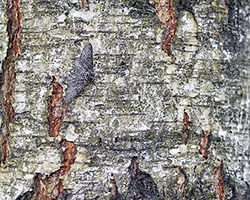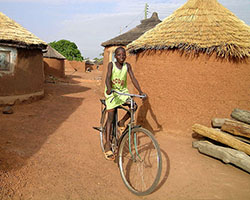show/hide words to know
Wings in a New Light
The peppered moth lands on the bark of a tree trunk and opens its wings to rest. A hungry flycatcher bird that was close behind swoops down for a meal but loses sight of its prey. The moth blended in with the tree trunk. Blending in let it avoid the pesky flycatcher, so the moth lives to see another day. This may seem like a simple act of nature, but scientists are quite curious about how and why these sorts of interactions arise.
The peppered moth's cryptic wing color is based on several different factors. How did an individual moth end up with that wing color? And why does this species of moth even have those wing colors?
The How and the Why
Scientists ask these sorts of questions and test them based on previous knowledge and future predictions. Some common questions focus on how a trait develops. This is known as the proximate cause. The proximate cause of the wing color in the peppered moth is genetic. A specific gene codes for whether they have light or dark-colored wings. In moths that survive and reproduce, the genes for a specific color is passed to their offspring.
Now, let’s look at the bigger picture. Why might an animal like the peppered moth have colored wings? Why a trait evolves is known as the ultimate cause. We now know that the wings of the peppered moth help the moths blend in. By blending in, their chances of survival increase. So in a specific environment, one wing color may help more moths survive than the other wing color. That's a pretty important benefit. The proximate cause and ultimate cause are often both involved in bringing about a trait that helps an organism survive in its niche.
Understanding both the proximate and ultimate causes helps us to understand why traits change over time. In non-polluted forests, moths with light wings were more likely to survive. In polluted forests, moths with dark wings blended in better. They were less likely to get eaten by birds and could then reproduce and pass their wing colors on.
We can also look at more familiar problems in terms of proximate or ultimate questions. Think of a bicycle. To go forward, you move the pedals. This turns the wheels, moving the bike. That is the proximate cause of how a bike works.
But what are the ultimate causes of why the bike moves? One proposal is that humans needed a faster way to get around. We designed the bike to help us move around faster and use our time more wisely.
If you're still confused about proximate vs. ultimate, try to think of it in a different way. Proximate and ultimate explanations also differ in the time scale over which they act. Proximate explanations focus on things that occur during the life of an individual. Ultimate explanations focus on things that occur in populations over many generations. Think you have a handle on the how and the why of biology?

Test Yourself
Try to come up with a few proximate and ultimate questions for the following adaptations: Moth color, group food searching in birds, parenting in mammals, and crying babies.
Tying It All Together
Both types of causation are interesting on their own. But realize that they are connected. We must study nature using both types of questions. This helps us to understand how traits evolve and benefit organisms.
Additional images via Wikimedia Commons. Elephant beetle by Derek Ramsey.
View Citation

Using proximate and ultimate questions help in the study of traits or behaviors of organisms. How and why might horns like this develop in an elephant beetle?
Be Part of
Ask A Biologist
By volunteering, or simply sending us feedback on the site. Scientists, teachers, writers, illustrators, and translators are all important to the program. If you are interested in helping with the website we have a Volunteers page to get the process started.










